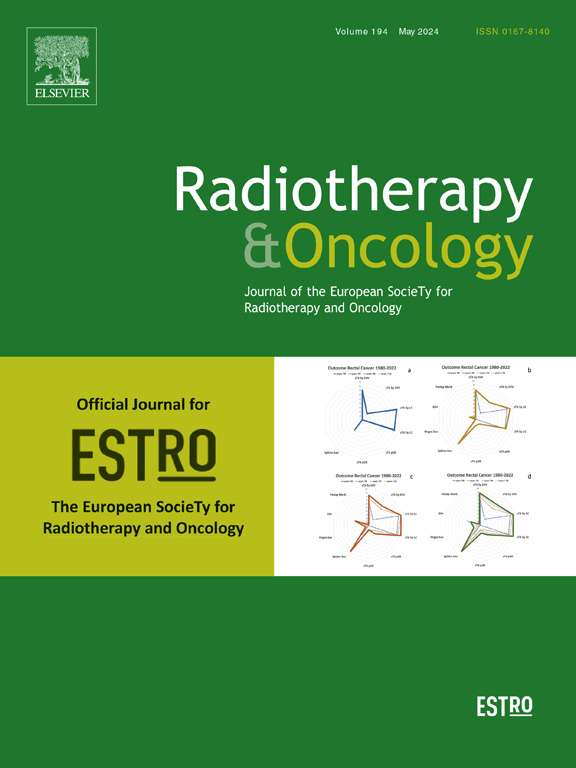Patient- and clinician-assessed five-year normal tissue effects following one-week versus three-week axillary radiotherapy for breast cancer: Results from the phase III FAST-Forward trial randomised nodal sub-study
IF 4.9
1区 医学
Q1 ONCOLOGY
引用次数: 0
Abstract
Background and purpose
FAST-Forward showed that 26 Gray (Gy) in 5 fractions (Fr) over one week adjuvant radiotherapy to breast or chest wall was as safe and effective as a three-week schedule (40 Gy/15Fr) for early breast cancer. The nodal sub-study investigated whether a one-week schedule is safe for adjuvant axillary radiotherapy.
Materials and methods
In this randomised, non-inferiority, non-blinded sub-study (ISRCTN19906132), patients with invasive breast cancer (pT1-3, pN1-3a, M0) following surgery requiring axillary radiotherapy (any or all levels 1–4) were randomised to 40 Gy/15Fr (three weeks, control), 26 Gy/5Fr or 27 Gy/5Fr (one week) atlas-based radiotherapy planning, including quality assurance. The 27 Gy/5Fr group closed early due to three-year main trial normal tissue effects suggesting 26 Gy/5Fr would be optimal; this analysis focusses on comparison between 26 Gy/5Fr and control. Primary endpoint was five-year patient-reported moderate or marked arm or hand swelling, aiming to exclude a 10 % increase (assuming 10 % incidence with control; 90 % power, one-sided α = 0.05, n = 172 per group).
Results
469 patients were randomised from 50 UK centres (182 40 Gy/15Fr, 183 26 Gy/5Fr, 104 27 Gy/5Fr). Median age 61 years; 250 (54 %) and 182 (39 %) had grade 2 and 3 tumours respectively; 261 (56 %) had axillary dissection. Of those who completed a five-year questionnaire, 11/107 (10 %) 40 Gy/15Fr and 13/116 (11 %) 26 Gy/5Fr reported moderate or marked arm or hand swelling, difference 1 % (90 % confidence interval −6%, 8 %, p = 0.49). Other arm and shoulder symptoms were similar between groups with no cases of brachial plexopathy.
Conclusion
Five-year patient-reported normal tissue effects suggest 26 Gy/5Fr/1-week hypofractionation is safe for breast cancer patients requiring adjuvant axillary radiotherapy.
患者和临床评估乳腺癌腋窝放疗后1周和3周的5年正常组织效应:来自III期快速推进试验随机淋巴结亚研究的结果
背景与目的fast - forward显示,对早期乳腺癌进行为期一周的5组26 Gy (Gy)辅助放疗与三周(40 Gy/15Fr)辅助放疗一样安全有效。淋巴结亚研究调查了一周的辅助腋窝放疗计划是否安全。材料和方法在这项随机、非效性、非盲亚研究(ISRCTN19906132)中,浸润性乳腺癌(pT1-3、pN1-3a、M0)术后需要腋窝放疗(任何或所有1-4级)的患者被随机分为40 Gy/15Fr(3周,对照组)、26 Gy/5Fr或27 Gy/5Fr(1周)基于图集的放疗计划,包括质量保证。27 Gy/5Fr组由于3年主要试验正常组织效应提示26 Gy/5Fr组最佳而提前结束;本分析的重点是26 Gy/5Fr与对照的比较。主要终点是5年患者报告的中度或明显的手臂或手肿胀,旨在排除10%的增加(假设对照组发生率为10%;有效率90%,单侧α = 0.05, n = 172 /组)。结果从50个英国中心随机抽取469例患者(182例40 Gy/15Fr, 183例26 Gy/5Fr, 104例27 Gy/5Fr)。中位年龄61岁;250例(54%)和182例(39%)分别为2级和3级肿瘤;261例(56%)行腋窝清扫。在完成五年问卷调查的患者中,11/107 (10%)40 Gy/15Fr和13/116 (11%)26 Gy/5Fr报告中度或明显的手臂或手肿胀,差异为1%(90%置信区间- 6%,8%,p = 0.49)。其他手臂和肩部症状在没有臂丛病的组之间相似。结论5年患者报告的正常组织效应表明,26 Gy/5Fr/1周低分割对需要辅助腋窝放疗的乳腺癌患者是安全的。
本文章由计算机程序翻译,如有差异,请以英文原文为准。
求助全文
约1分钟内获得全文
求助全文
来源期刊

Radiotherapy and Oncology
医学-核医学
CiteScore
10.30
自引率
10.50%
发文量
2445
审稿时长
45 days
期刊介绍:
Radiotherapy and Oncology publishes papers describing original research as well as review articles. It covers areas of interest relating to radiation oncology. This includes: clinical radiotherapy, combined modality treatment, translational studies, epidemiological outcomes, imaging, dosimetry, and radiation therapy planning, experimental work in radiobiology, chemobiology, hyperthermia and tumour biology, as well as data science in radiation oncology and physics aspects relevant to oncology.Papers on more general aspects of interest to the radiation oncologist including chemotherapy, surgery and immunology are also published.
 求助内容:
求助内容: 应助结果提醒方式:
应助结果提醒方式:


